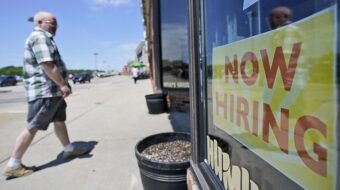Book Review
“Wage Theft In America, Why millions of working Americans are not getting paid and what we can do about it”
By Kim Bobo
The New Press, 2009, 314 pp, $17.95
“Is that about the two and half million prison workers?” my nurse asked as she walked to my bed. I was reading Kim Bobo’s book, Wage Theft In America, while recovering from knee surgery. Bobo’s book was so compelling that it took my mind off my knee.
A shameful crime wave of epidemic proportions, wage theft in America exceeds $19 billion annually and affects about two million workers. And that does not even include the prison workers that my wonderful nurse had mentioned.
Employers are guilty of wage theft when they steal all or part of a worker’s pay. To me, stealing from workers’ wages is a crime even lower than stealing from a blind man’s alms box. I, myself, have been a victim of wage theft. Members of my family, including my husband and my father-in-law have had even worse experiences. The sad part is that the wage-stealing employers have gotten away with it. Few realize the extent of wage theft because the mass media have chosen to look the other way. This fast-growing crime wave has not made any headlines or major TV shows. But this is about to change.
Kim Bobo’s hard-hitting book shines a bright searchlight on the wage theft criminals. She analyzes the different forms by which wages are stolen. My case comes under “not paying the last week worked.” In 1944, I had worked a full year for Sylvania Radio and had earned one week’s vacation pay. That would have been the first time in my life to enjoy a paid vacation, unheard of on most jobs before the CIO. I never did get the vacation pay that I had earned. I thought it was because I was leaving on maternity leave. Union contracts were then new to many; the CIO was less than ten years old. Only later, did I realize that I had been cheated.
Wage theft enforced by terror
Sheer terror keeps many from complaining about wage theft. Bobo shows this is still true, especially for immigrant workers. However, Bobo adds that most victims of wage theft are U.S. citizens.
My father-in-law Elmo’s experience was typical in the pre-1960 Civil Rights South. In those years, wages were paid in cash placed inside pay envelopes. There was often a short count, but fear kept many from complaining. Not my father-in-law, Elmo! He opened his envelope and refused to move the pay line until he counted his money. It was short. “It’s $1.50, short,” he said and refused to move until it was paid. The white paymaster was giving him dirty looks and some behind Elmo left the line in fear. After a long pause, the paymaster put Elmo’s missing $1.50 into the envelope and the line moved on.
Elmo told me a “joke” about a sharecropper’s attempt to get his full share of the crop. Although “crop shares” are not the same as wages, it is a similar issue.
A sharecropper brought his cotton to the landlord’s agent for reckoning. After figuring and figuring, the agent told the sharecropper, “Well your cotton comes out just even with the supplies you got from the company store and the seed the landlord gave you. You broke even.”
“Now, what should I do with the cotton that I have in my attic?” the sharecropper asked.
“Darn!” said the agent. “Now I have to figure it all over again.”
My husband, Frank, was one of over 3,000 Wisconsin Steel workers who did not get their last two weeks’ wages when the Chicago mill closed suddenly, March 28, 1980. The paychecks they got the night before, for two earlier weeks’ work, bounced all over town. That made a total of four weeks’ work not paid. But State agencies could find no laws that had been broken! It took an eight year fight in and out of court to win payment of back wages plus another eight years fighting to win some other earned benefits. In bankruptcy court we learned that unpaid wages get last, not first consideration. Wages are considered unsecured” debts. They are not paid in bankruptcy courts until secured loans, such as bank loans, are paid first.
Failure to pay overtime
Bobo writes that the largest mass of unpaid wages comes from employers’ refusal to pay time and a half for overtime, or failure to pay any overtime wages. Familiar corporate names head the list of offenders who have been forced to make settlements: Wal-Mart, $33 million to 86,680 workers for unpaid overtime, insurance companies: Farmers, State Farm, Allstate for a total of $455 million for 8,002 adjusters, IBM, $65 million for 32,000 tech workers.
Women are hit hardest by the epidemic of stolen wages. Except for construction, women are the majority in the most affected industries: Garment factories, nursing homes, farms, poultry plants, and restaurants.
How to end wage theft
To date, wage theft has gone largely unpunished. Enforcement of the minimum wage and Fair Labor Standards Law is in the hands of the understaffed Department of Labor. Fines are seldom imposed on offenders and are so small as to be laughable. The department has been stacked with anti-labor, pro-employer appointees by Republican presidents. However, with Obama’s appointment of Hilda Solis as secretary of Labor, that culture can be changed. This is a good time for Bobo’s concrete suggestions for strengthening the Department of Labor’s enforcement of the labor laws.
Bobo draws on her experience as founder and executive secretary of Interfaith Workers Justice in Chicago. In Wage Theft she proposes steps to make the Department of LAbor an effective agency to end wage theft. That is their job and they should do it.
However, Bobo makes it clear from the start that a worker’s first line of defense against wage theft is a union. The organization that she leads, Interfaith Workers Justice, works closely with unions, religious and community groups. Her book makes a strong argument for passage of the Employee Free Choice Act, to protect workers’ rights to join a union. To try to meet the needs of workers who have no union, IWJ is organizing Workers’ Centers.
Workers’ Centers
Bobo’s commitment to workers’ causes and organized labor is inspired by her religious convictions. She supplies wonderful references to the New and Old Testaments and to the Qur’an for passages condemning wage theft. She could have gone even further back to ancient Egyptian, Indus or Chinese moral teachings.
The work of Interfaith Workers Justice provides a wonderful example of how to build the broadest unity to support working families’ fight for justice. IWJ has organized Workers Centers that deserve the support of all progressives. The Centers are a resource on the ground for unorganized workers, whether citizen or immigrant, whether with papers or undocumented, to win justice on such issues as wage theft. Winning justice for one worker often involves organizing a whole group of workers. In the course of organizing, more workers learn to become leaders.
Bobo writes of the proud tradition on which Workers’ Centers are being built. Even though these are “relatively new models for helping workers who are being exploited in the workplace,” the idea of safe centers where immigrants and low-wage workers can get help is not new. Workers centers are in the long tradition of community and labor centers that support workers challenging wage theft and other forms of exploitation. These Centers advocate unions and work for ethical legislation, and public understanding of worker issues. Specifically Bobo mentions settlement houses and the work of Jane Addams and Florence Kelley, Labor Lyceums and the (Jewish) Workmen’s Circles, the Catholic Labor Schools and the Farm Worker Service Centers.
There is indeed a very rich tradition of workers clubs in the United States. They were different from the settlement houses because they were organized by the workers themselves, rather than for the workers. At least 15 different language groups organized such clubs in many states, most affiliated to the (IWO) International Workers Order. They provided low-cost life insurance, some had medical and dental clinics, and supported foreign-language newspapers and other cultural activities. Many were also centers of workers’ action.
In 1938, I lived across the street from the Pan-Cypriot Club of the IWO in New York’s Hell’s Kitchen. On Saturday nights I enjoyed their music and watched the Turkic dances, all from my apartment window.
When I moved to Chicago in 1949, the Lithuanian and Russian clubs and probably others still had their own buildings and newspapers. In 1954, the IWO fell victim to the McCarthy purges and was dissolved. I hope some historian(s) will write a comprehensive history of some of these clubs. Much could be learned from their rich cultural and political life.
Frances Perkins
Another wonderful chapter in Wage Theft is about Frances Perkins, FDR’s secretary of Labor and the first woman elevated to a cabinet post in our country. Bobo presents Perkins as “the most important Secretary of Labor in the Nation’s history.” and a model for what is needed now. It is Bobo’s hope that the new secretary of Labor will get backing from President Obama as strong as Perkins got from President Roosevelt. The connection between Roosevelt and Perkins was very strong. Before she accepted appointment as President Roosevelt’s secretary of Labor, Perkins outlined her vision for overcoming the Great Depression. She proposed federal aid to pay unemployment relief, extensive public works projects to create jobs, laws for a minimum wage and maximum work week, abolition of child labor, old age pensions and a federal-state employment service. In short, she outlined a New Deal.
This reviewer had the pleasure of meeting Perkins in 1938. Perkins was the featured speaker at a meeting of the American Labor Party on the West Side of New York. The meeting was in a school classroom and I sat in the front seat of the middle row. Perkins set me on fire. I was 19 at the time. I think she noticed me, too, because in her next newsletter, she wrote about “the intense young woman who sat up front at the meeting.”
If the new leadership of the Department of Labor follows the Perkins model for the Department of Labor, we will take giant steps to end wage theft in America.

MOST POPULAR TODAY


Zionist organizations leading campaign to stop ceasefire resolutions in D.C. area

Communist Karol Cariola elected president of Chile’s legislature

High Court essentially bans demonstrations, freedom of assembly in Deep South

Afghanistan’s socialist years: The promising future killed off by U.S. imperialism






Comments